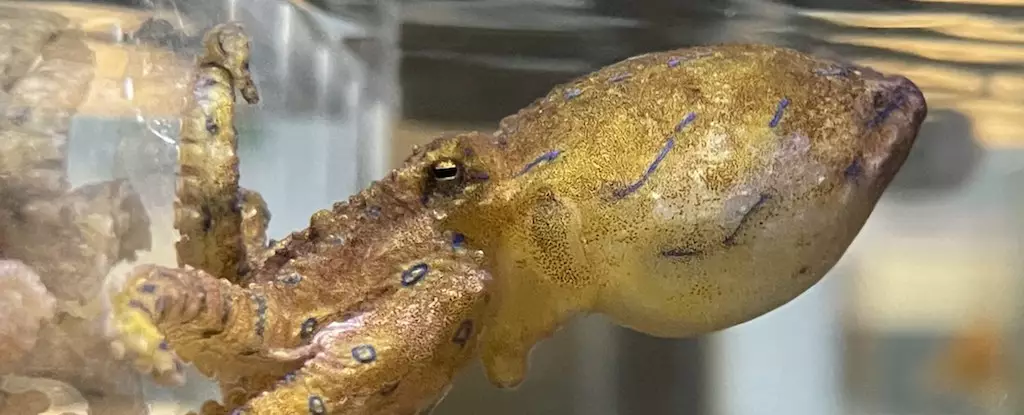As we dive into the depths of the ocean, we are met with mysteries and marvels of life that provoke wonder and warrant respect. One creature that encapsulates this dichotomy of awe and fear is the blue-lined octopus (Hapalochlaena fasciata). This diminutive marine inhabitant might only extend a few centimeters, yet it serves as a potent reminder that beauty can cloak deadly danger. In an unsettling evolutionary twist, this creature possesses not just visually striking blue rings, but also the powerful neurotoxin known as tetrodotoxin (TTX). This article aims to dissect the complex dynamics life presents in these enigmatic beings, particularly focusing on the perilous mating practices of its male counterparts.
Small Size, Big Threat
Ironically, the very traits that deem the blue-lined octopus harmless to many can be its undoing. The female, often twice the size of her male counterpart, creates an immediate power imbalance that makes mating a life-threatening venture for males. This paradox is not merely a quirky aspect of these creatures; it highlights the often ruthless and competitive nature of survival in the animal kingdom. The act of mating becomes a high-stakes gamble that can end in the male’s demise. It is a stark reminder that nature doesn’t coddle; it indiscriminately favors those who develop cunning survival strategies.
Intriguingly, male blue-lined octopuses have evolved a strategy that displays a bewitching mix of aggression and intelligence. Recent studies reveal that before engaging in the risky act of mating, the male employs its own venom as an unlikely protective mechanism. By delivering a precise bite near the female’s aorta, the male momentarily paralyzes his partner, transforming the lethal game of courtship into a calculated act of seduction. This adaptability of using venom not just for defense but for reproduction raises profound questions about the nature of instinct and survival across species.
A High-Risk Romantic Strategy
The inherent danger of the mating ritual among blue-lined octopuses is akin to a high-stakes poker game, where the players are all in yet precariously balanced on a razor’s edge. This strategy of using TTX is unique among octopus species, painting an intriguing picture of evolutionary arms races. Typically, female octopuses engage in cannibalistic behavior; the males are not simply vying for mating rights but are entangled in a fight for their very existence. The modern romantic landscape, it seems, has devastatingly reflected survival instincts at their most brutal.
Moreover, the behavior of males during mating showcases a complex understanding of their surroundings. While other species have evolved longer arms or the ability to sacrifice limbs to escape, male blue-lined octopuses seem to have made a different evolutionary choice—and it’s one fraught with peril. Their reliance on venom for survival rather than physical adaptability illuminates a fascinating complexity that must be acknowledged when discussing their mating behaviors.
The Role of TTX: More Than Just a Poison?
TTX is not merely a primal defense mechanism; it plays a multifaceted role that influences not just predation, but the very fabric of reproductive success. In a study observing mating behaviors, researchers noted significant variations in the breathing rates of males and females during copulation. These findings suggest a neurological reconfiguration that accompanies TTX activation, which ultimately reveals a surprising yet alarming dimension to the mating act. The females enter a state of paralysis in which they lose crucial reflexive functions, essentially becoming unable to react or resist.
What’s more shocking is that despite this incapacitation, none of the females met a fatal end during these encounters. This raises deeper inquiries regarding their possible resistance to tetrodotoxin. Could it be that females possess some biochemical fortitude that allows them to endure what is essentially a biological assault? The implications of such findings challenge us to reconsider our understanding of biochemical vulnerability and resistance in the natural world.
Interplay of Evolutionary Strategy and Behavior
As anthropocentric observers, we often forget that nature operates on unfathomable principles that defy our moral constructs. The blue-lined octopus serves as an emblem of this unsettling reality. The behaviors that seem horrific to us are vital elements of survival in the narrative of marine life. The intoxicating mix of danger and beauty encapsulated in the blue-lined octopus is indicative of life’s cruel propensity for drama, where adaptation oftentimes translates to violence.
Thus, in examining the perilous mating rituals of the blue-lined octopus, we unveil not only a fascinating chapter in marine biology but also a cautionary tale about the stark realities of life. This tiny yet formidable creature encapsulates the complexities of existence, love, and survival in a world where every decision can spell life or death. Each interwoven piece of biology within the blue-lined octopus not only reflects its struggle against the odds but also reminds us of the delicate equilibrium we often take for granted in the natural world.


Leave a Reply